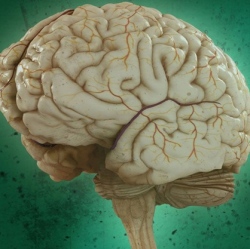
The largest network of the connections between neurons in the cortex to date, mapped from about 100 terabytes of data, has been published by an international team of researchers from the Allen Institute for Brain Science, Harvard Medical School, and Neuro-Electronics Research Flanders (NERF).
In the process of their study*, the researchers developed new tools that will be useful for “reverse engineering the brain by discovering relationships between circuit wiring and neuronal and network computations,” says Wei-Chung Lee, Ph.D., Instructor in Neurobiology at Harvard Medicine School and lead author of a paper published this week in the journal Nature.
The study is part of a “functional connectomics” research program started almost ten years ago that aims at bridging a longstanding gap between two areas of neuroscience study: brain activity (using fMRI imaging) and brain wiring (using detailed electron microscopy).
The research began by identifying neurons in the mouse visual cortex that responded to particular visual stimuli (pyramidal cells in V1, the rodent primary visual cortex), such as vertical or horizontal bars on a screen.
The scientists then made ultra-thin slices of brain and captured millions of detailed images of those targeted cells and synapses, which were then reconstructed in three dimensions. Teams of annotators simultaneously traced individual neurons through the 3D stacks of images and located connections between individual neurons.
Analyzing this wealth of data yielded several results, including the first direct structural evidence to support the hypothesis that neurons that do similar tasks are more likely to be connected to each other than to nearby neurons that carry out different tasks.
The researchers said these new research tools will also be employed in an $18.7 million IARPA project announced March 12 with the Allen Institute for Brain Science, Baylor College of Medicine, and Princeton University, which seeks to scale these methods to a larger segment of brain tissue. That project is part of the Machine Intelligence from Cortical Networks (MICrONS) program (see CMU announces research project to reverse-engineer brain algorithms, funded by IARPA), which seeks to revolutionize machine learning by reverse-engineering the algorithms of the brain.
The 3D image data from the Allen Institute-Baylor study will be sent to Princeton University, under Sebastian Seung, Ph.D., Professor of Computer Science and the Princeton Neuroscience Institute, where it will be painstakingly reconstructed in three dimensions by human annotators aided by powerful machine vision and machine learning algorithms, and each individual neuron with all its myriad processes will be traced and analyzed.
The end goal of that functional connectomics project is to create a reconstruction of a cubic millimeter of brain tissue, the size of a grain of sand, yet containing the largest section of brain ever to be studied in this way to date.
Beyond that, the ultimate goal of MICrONS is to implement the algorithms and learning rules that scientists decipher from the brain to advance the field of artificial intelligence by improving artificial neural networks algorithms, for speech recognition, recognizing faces, and helping analyze big data for biomedical research, for example.
“In many ways, these artificial neural networks are still primitive compared to biological networks of neurons and do not learn the way real brains do,” says Andreas Tolias, Ph.D., Associate Professor in the Department of Neuroscience at Baylor College of Medicine. “Our goal is to fill this gap and apply the algorithms of the brain to engineer novel artificial network architectures.”
